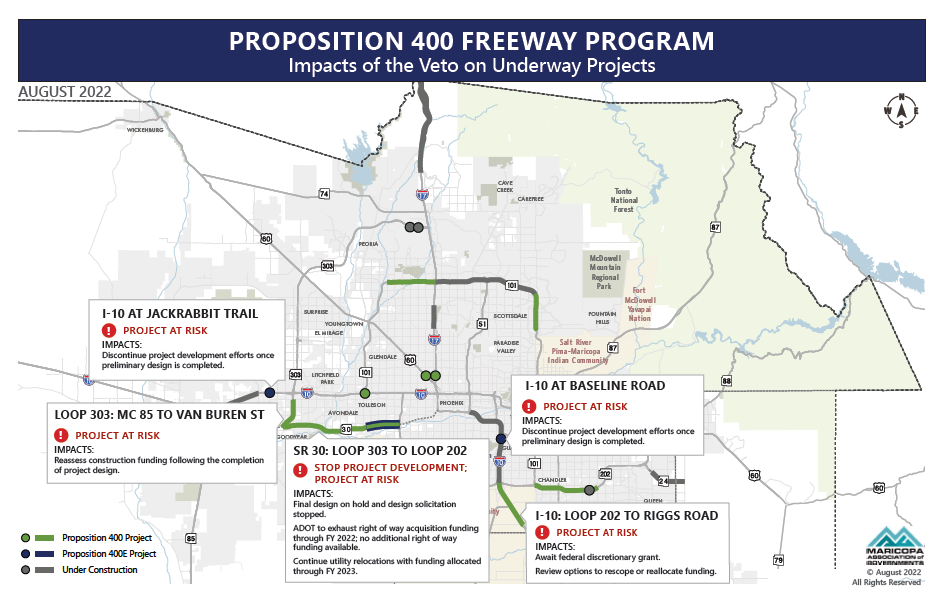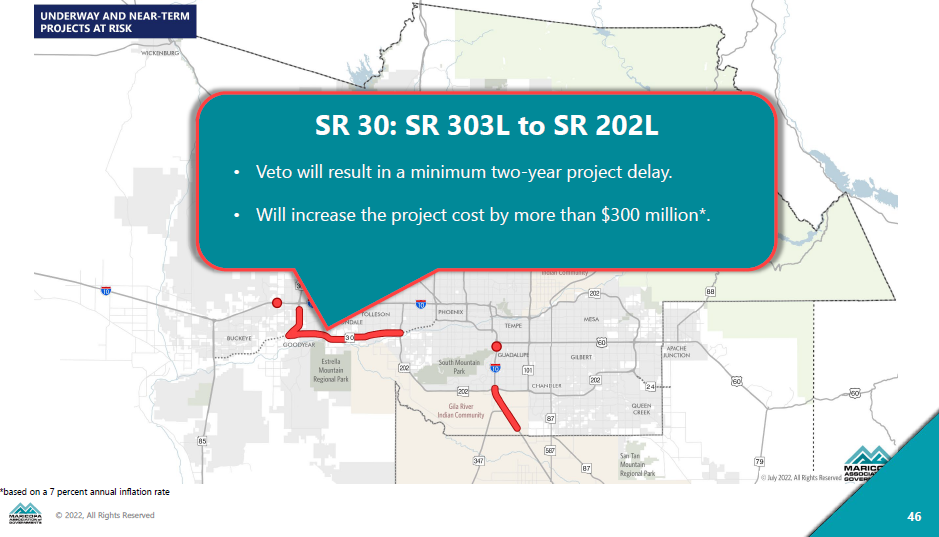By Roland Murphy for AZBEX
While normally regarded as one of Arizona’s more pro-economic development and infrastructure governors, Governor Doug Ducey’s July veto of a bill that would have sent an extension of the Proposition 400 half-cent sales tax – a major funding source for Maricopa County transportation projects since 1985 – has already caused delays and ripple effects for major projects deemed essential for the county’s progress.
After years of planning and extensive negotiations between the Maricopa Association of Governments, regional leaders and the Arizona State Legislature, HB 2685 was passed in the most recent legislative session. The bill would have asked Maricopa County voters to approve a 25-year renewal of the half-cent sales tax in a spring 2023 special election.
The extension, alternately referred to as Prop 400 and Prop 400E, was expected to generate more than $36B for highway, primary roadways and other transit projects over its 25-year timeline.
Mayors across Maricopa County unanimously supported the request, and the Governor’s approval was widely considered a pro forma detail. Officials, supporters and government observers both in and out of the news media were caught flat-footed by the veto.
In the official letter to the Secretary of State’s Office explaining his veto, Ducey offered three primary criticisms of the bill and expressed his general disapproval of its timing and adoption process. The itemized objections were:
- The funding timeline. Earlier iterations of the tax had 20-year lifespans. The renewal called for 25 years. Ducey said, “The additional five years are a tax increase and should not be perceived as a tax continuation.”
- Project focus. The Governor said previous work under Prop 400 focused primarily on freeway projects and that the extension reduced the amount of freeway funding and did not provide a clear framework for the maintenance of existing freeways as they age.
- Other funding sources. Ducey said the tax was planned before Congress passed the Infrastructure Investment and Jobs Act and did “not account for the opportunity to properly leverage state dollars for federal transportation infrastructure funding.”
He cited the burdens placed on taxpayers from rising inflation as making it an inappropriate “time to ask Arizona voters to tax themselves,” and criticized the fact that the vote would have been taken in a special spring election in 2023, “when voter turnout will likely be low.” The Governor reasoned the measure could have waited until the November 2024 election since the tax is not set to expire until the end of 2025.
We will examine Prop 400E, HB 2685, the veto and the broader behind the scenes details and repercussions in Friday’s column. That said, there are several glaring shortcomings in the Governor’s reasons that have to be addressed in today’s discussion.
First, ongoing project work is predicated on future funding. If a project’s funding faces the likelihood of disappearing at 12:01 a.m. on January 1, 2026, it would be an irresponsible waste of time and money to work toward that project today. Having the extension approved by voters and on the books moving forward would have prevented disruptions to work that extends past 2025.
Second, major projects planned by the Arizona Department of Transportation and for which IIJA monies and other allocations may be expected usually have a requirement for local matching funds, which are, in part, what the Prop 400 funds provide.
While we will not attempt to divine the Governor’s rationale or motivations for the veto beyond what he, himself, has expressed, today we’re going to briefly examine the State Route 30 Tres Rios project to provide a general framework for the situation and how the veto is already generating near-term impacts on long-range infrastructure development.
SR 30 Overview

SR 30 is a planned approximately 29-mile roadway that will relieve congestion on Interstate 10 in the southwest Valley. The highway’s general path connects Phoenix and Buckeye and lies four miles south of I-10. An earlier 24-mile vision for SR 30 connecting Buckeye and Avondale was included in the Prop 400 renewal passed in 2004. That version was put on hold in 2009 due to revenue decreases in the Great Recession.
As quoted in the DATABEX detailed project description of the current SR 30 Tres Rios plan: “In January 2020, a Location/Design Concept Report (L/DCR) and Final Environmental Assessment (EA) were completed for the SR 30 corridor from the proposed SR 303L to SR 202L. The ultimate corridor improvements include construction of a 10-lane barrier-divided, access-controlled urban freeway that provides four general purpose lanes and a high occupancy vehicle lane (4+1) in each direction and a full system interchange with SR 202L.”
The freeway is planned in five sections, with costs allocated for each:
- Loop 303 (Estrella Freeway) to Estrella Parkway – $590.8M
- Estrella Parkway to Dysart Road – $364.9M
- Dysart Road to Avondale Boulevard – $114.1M
- Avondale Boulevard to 97th Avenue – $159.6M
- 97th Avenue to Loop 202 – $899.9M.
In ADOT’s Capital Improvement Plan for Fiscal Year 2021, funding was allocated as follows:
- Prior Years: $128M
- FY2021: $66M
- FY2022: $56M
- FY2023: $153M
- FY2024: $185M
- FY2025: $4.9M.
The impending arrival of a major reliever freeway has been one of several factors in Buckeye’s growth, particularly in industrial development. In 2019, Buckeye was identified as the fastest growing city in the country with a population of more than 50,000. In May, the City’s Planning and Zoning Commission approved a request to redesignate 1,300 acres south of I-10 from Neighborhood to Industrial under the general plan. The combination of railway access and proximity to SR 30 were key benefits cited in the request.
Also in May, ADOT issued a Request for Qualifications for final design of the Tres Rios freeway and system interchange from 67th Avenue to Loop 202-South Mountain Freeway and from 67th Avenue to 97th Avenue. The scope of work included:
- Designing and preparing final construction plans, technical specifications, cost estimates and construction documents,
- Preparing an Americans with Disabilities Act Compliance and Feasibility Report,
- Preparing an Initial and Final Materials Design Report and an Initial and Final Pavement Design Summary,
- Confirming right-of-way and temporary construction easements,
- Updating the Final Environmental Assessment, and several other tasks essential to moving the project forward.
Three consultants with assembled teams of subconsultants totaling 20 contributing firms submitted responses.
Because of the uncertainty introduced by Ducey’s veto and the possible future of Prop 400 funding, the design services RFQ was canceled in August. As of September 14th, ADOT representatives said there are currently no plans to re-advertise the request.
The design elements solicited in the withdrawn RFQ had allocations totaling $47M under the FY 2022 CIP.
Veto Triggered Lasting Repercussions

According to an update provided in the May 19th MAG Board meeting, “Funding to construct the SR 30 has been identified in Phase I of the Proposition 400 extension investment plan. As of February 2022, more than half of the needed parcels have been acquired through right of way acquisition or are in the process of being acquired. Funding to initiate final design on the portion of SR 30 between 97th Avenue and Loop 202 (South Mountain Freeway) has been programmed in Fiscal Year 2022. Design is expected to take two years to complete.”
In a video conference with AZBEX last month, Maricopa Association of Governments’ Transportation Economic and Finance Program Manager John Bullen and Transportation Planning Program Manager Audra Koester Thomas explained how the veto has already triggered repercussions and delays for the Tres Rios project.
AZBEX NOTE: Audra Koester Thomas is a featured speaker at next week’s BEX 2022 Public Works Conference.
Bullen called the project an “incredibly important connection” and explained that it is planned to carry more than 100,000 vehicles per day by 2040 and to serve as a vital contributor to freight mobility. “That’s a project that people want and they want now.”
Under the Prop 400 program, approximately $550M was allocated for right of way acquisition and advanced utility relocation. “There has been no project in this region better set up to move to construction quickly than that center segment of State Route 30,” Bullen said. “All the development work is occurring behind the scenes, and as soon as we get the extension in place, we could fairly quickly go out there and start turning dirt. It is set up extremely well to move very quickly, but that’s all come to a screeching halt now.”
Bullen explained ADOT has encumbered roughly half of the right of way funding and until there is a clear path to the ballot for future funding there will not be any more right of way work. “Some of those efforts are slowing down or stopping, in reality,” he said. “We had set to start final design on the first portion… from 97th Avenue over to the Loop 202 interchange. It’s about a $900M construction project. The final design solicitation for that portion had been on the street. After the veto, it was canceled.
“So, at this point, we’re at least one year behind on a $2.1B (project), and the longer it is before we have a clear path to the ballot, the more delay you’re going to add in.” He continued, “If you think about it, we’re a year behind in the right of way acquisition and it’s just now slowing down. Every week, every month from this point forward, it’s not a linear delay; it’s an exponential delay. Those are real consequences.”
Materials produced by MAG estimate the veto will result in a two-year delay and add more than $300M to the final project cost.
Bullen wrapped up his summary of the SR 30 impacts suffered as a result of the veto by saying, “You are seeing this critical piece of infrastructure where you have private development investing hundreds of millions of dollars that is now delayed because of the veto.”
Offering up a general overview of the current situation and the need to find a path to the ballot Bullen said, “There’s three years left in Prop 400. In reality, there’s a lot predicated on the future revenue stream, and there’s an immediate consequence.”
In Friday’s issue we will take a deeper dive into the overall economic development and infrastructure impacts of Prop 400E, the history of the HB 2685 in the last legislative session, the veto, the broader impacts and the scramble for a legislative path back to the ballot.


